Since the par (standard) racetime charts for Brisbane, Melbourne and Sydney were published in Practical Punting Monthly in September 2004, I’ve had numerous requests in regard to the publication of the charts for the other tracks.
So as part of this month’s article, the par racetime charts for the metropolitan tracks in Adelaide and Perth, along with those for the provincial tracks in New South Wales, Queensland and Victoria are published.
As I mentioned in the earlier article I believe these charts are unique in as much as they are the first to be made readily available to the Australian public for some considerable time, and in some instances, for the first time ever.
When the charts for Brisbane, Melbourne and Sydney were formulated they were derived from close to 750,000 individual horse runs and over 90,000 races.
Well, since then the database has grown somewhat and now contains close to 900,000 individual horse runs and over 107,000 races.
While working with such a large data source provides a degree of reliability and stability in the outcomes, it must again be pointed out that in some instances, some of the par times are based on minimal data, particularly when it comes to wet track conditions.
With this in mind, I have not published any par racetime charts races run on heavy tracks at the provincial centres and caution should be used with those provided for slow tracks outside of the capital cities.
Par racetime charts are a very useful tool when used correctly but they are not a selection method in their own right, but should be used as part of the overall form analysis.
However, I must admit it is pleasing to have received some positive feedback by users, including some from overseas.
The following email from Barry B., a New Zealand reader of Practical Punting Monthly, is typical of a number of responses received,
“In the September issue of PPM…tables for par times for the metropolitan courses of Brisbane, Sydney and Melbourne (were published). I have been using (these) in a system I have been working on for a few months. Using the published figures to find whether a horse is fit enough to run today, based on its time last start etc, I have been having a great run.
One race analysed in Melbourne each Saturday since last August, less a couple of weeks off on holiday, has returned a 100 per cent place dividend (average $2.20) and a 42.9 per cent win return (averaging $6.35). Overall, 21 selections for 9 wins, including (winners at) $11.50 and $11.40, and 21 placings.”
In response to Barry, I wrote (in part) the following, “The development of the par racetime charts consists of literally hundreds of queries and calculations so they do take some time to compile. Yours is one of a number of similar requests and I’m working on the development of the other charts currently.”
The best way to use par time charts is for comparing performances on the day and at that track, taking into account favourable or unfavourable pace and other in-running factors.
Factors such as were the racetimes on the day at that meeting generally faster or slower than the par expected for the prevailing track conditions?
The most glaring example of a “fast” track occurred at Moonee Valley on October 24 1998 when Might And Power won the W.S. Cox Plate in a track record time of 2.03:54 (123.54s), a time 1.84secs faster than any other at this track since the laying of the StrathAyr surface. In all, 16 horses at that meeting broke the prevailing track records at the time, with 10 of the 11 runners in the Cox Plate achieving this feat.
Using the racetimes from this meeting as a guide for future performance was of little assistance, a fact borne out by the fact that very few of the Cox Plate runners ever won another race.
A more recent example occurred at Randwick on February 12 this year when arguably Australia’s best racehorse Grand Armee broke the track record in winning the Apollo Stakes. However, two track, three class and one race record were broken at that meeting, indicating that caution was required in basing any future assessment on the racetimes.
A more discerning approach is to isolate the exceptional performances; such as young horses running times better than or about equal to par, particularly early in their careers. One such horse that meets this criterion is the Tony Vasil trained two-year-old filly Opportunity, who as this article is being written is the pre-post favourite for the Blue Diamond Stakes.
Opportunity at its first race start ran 63.67s in winning a 1100m maiden race at Ballarat, a time that was only 1/10th of a second slower than the par time – a very good time for a two-year-old.
It then followed this up by winning at Moonee Valley nine days later, winning a 1200m race in a time of 70.88s, some 7/10ths faster than the par time and less than a second outside of the track record – quite exceptional for such a young horse having its second race start. In fact, of the four 1200m races at the meeting, it ran the second fastest time and one that would have made it competitive in the Group 1 Australia Stakes at weight-for-age.
Notes:
- The par times contained in these charts do not include racetimes derived from either maiden or two-year-old races.
- Where no time is indicated (0.00), which is mainly for dead, slow and heavy tracks, this is due to insufficient data. Victoria Park does not provide any sectional times.
Legend:?RTime = Race Time,?STime = Sectional Time.
ADELAIDE
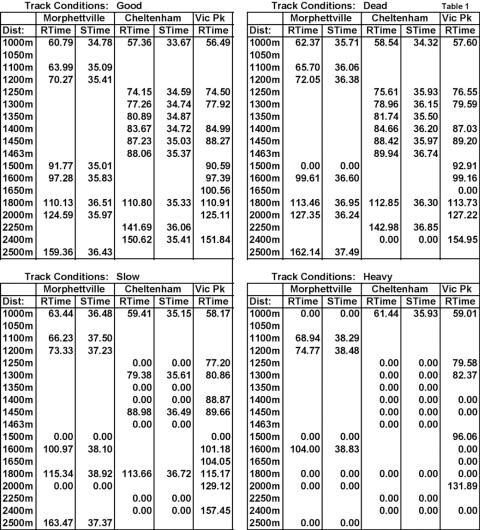
PERTH
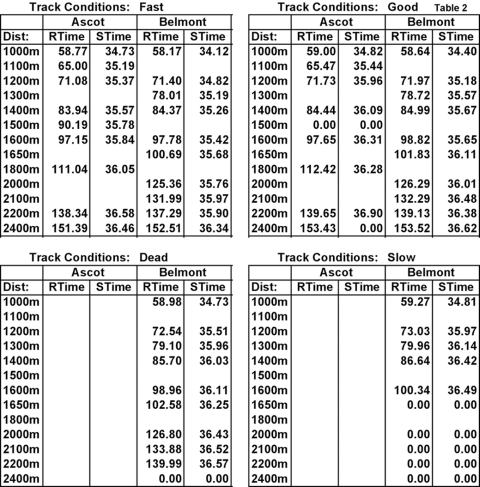
MELBOURNE
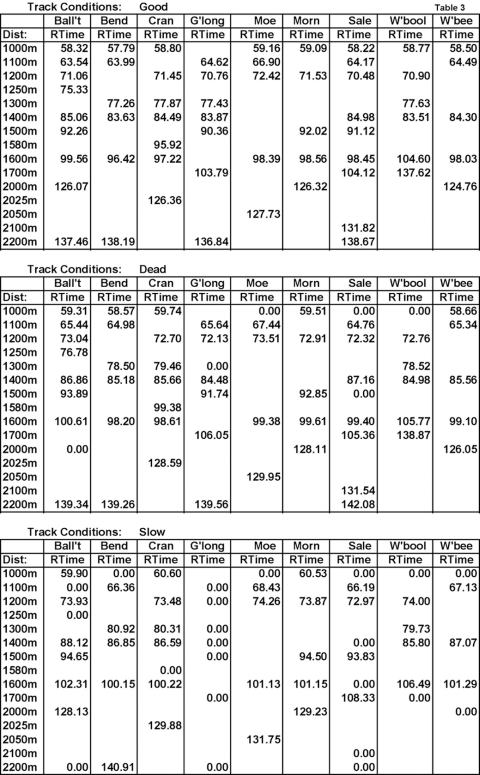
NEW SOUTH WALES
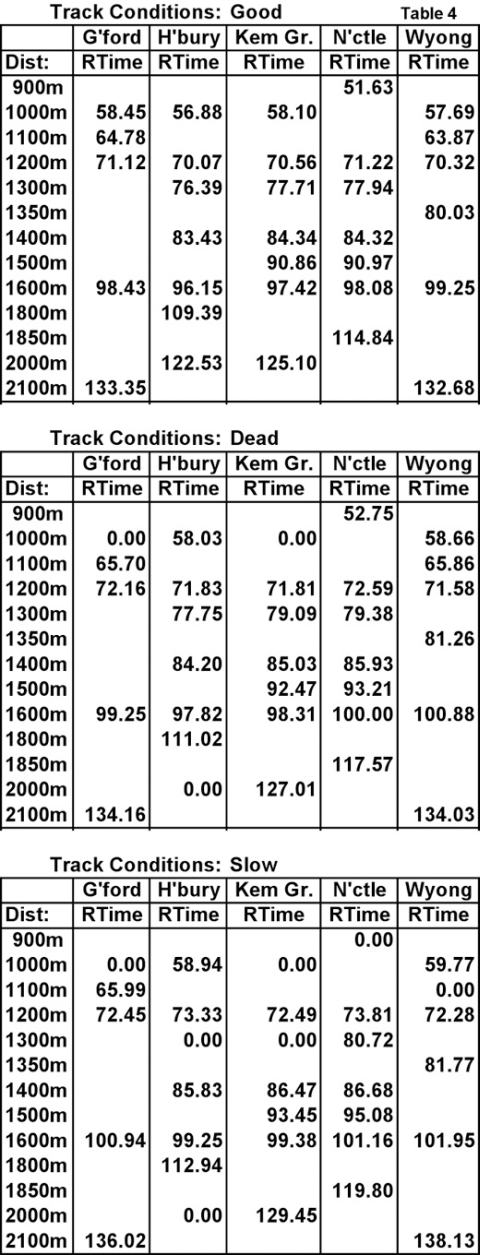
QUEENSLAND
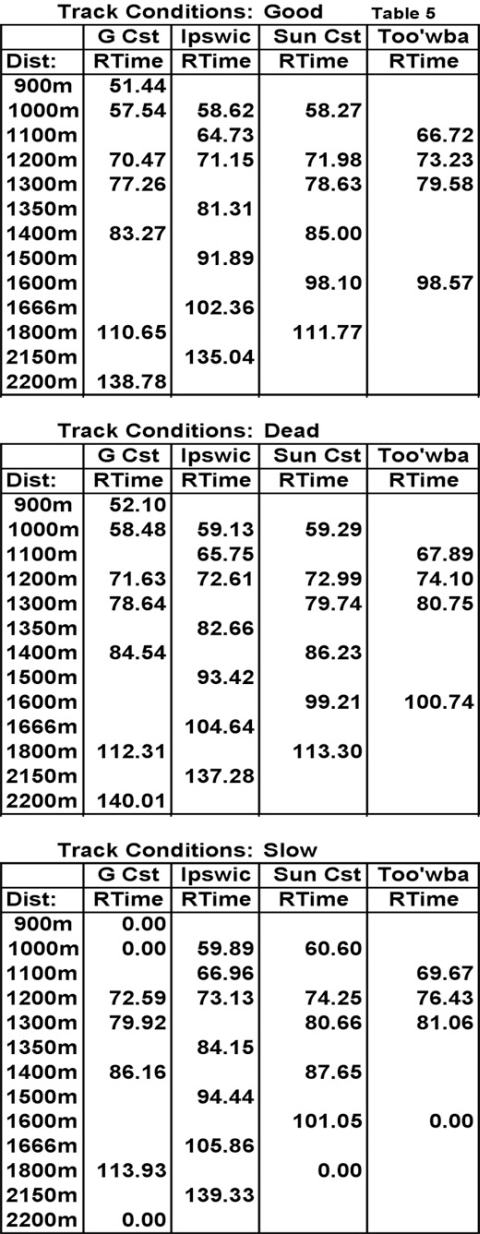
By EJ Minnis
PRACTICAL PUNTING - APRIL 2005